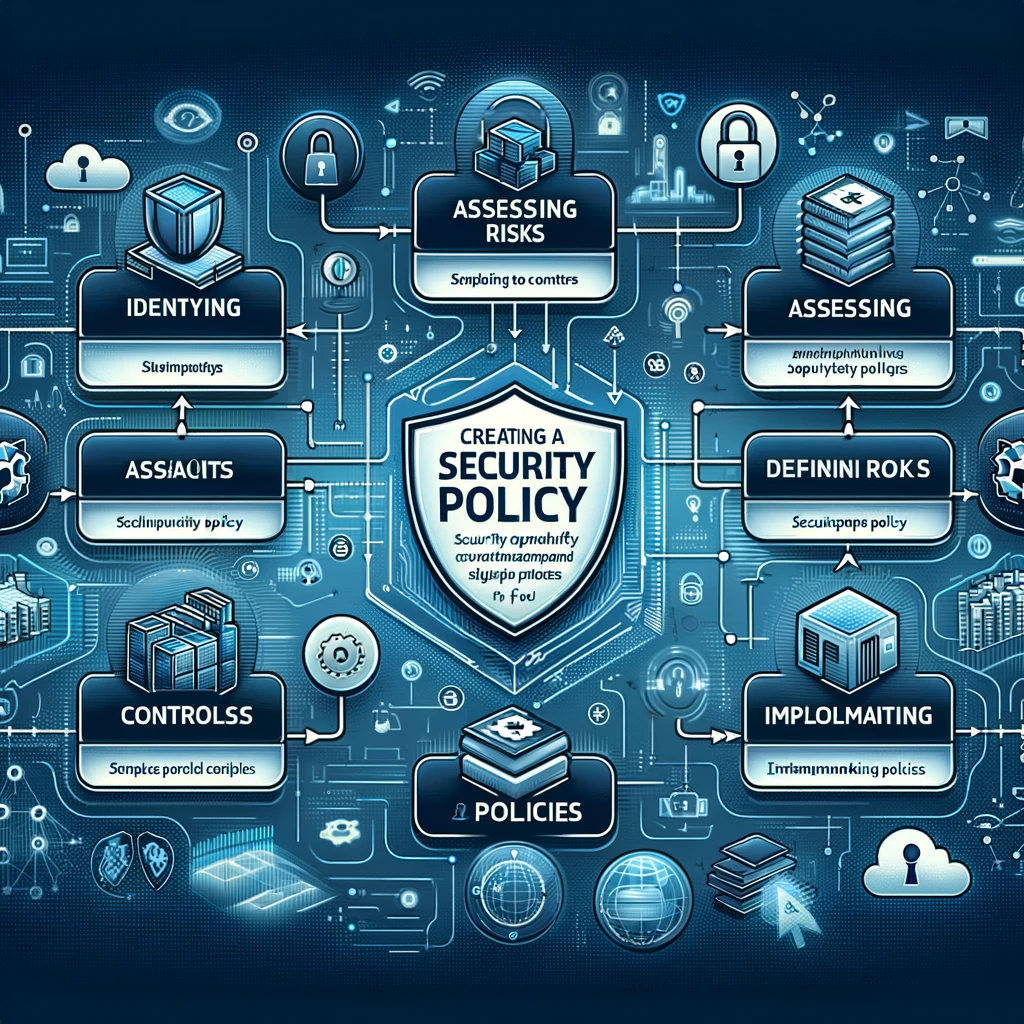CREATING EFFECTIVE INFORMATION SECURITY POLICIES AND PROCEDURES

Effective information security policies and procedures form the cornerstone of a robust cybersecurity framework. As the digital landscape continually evolves, so does the complexity of potential security threats.
This makes it imperative to design and implement effective security policies and procedures that can adapt to new challenges.
In this post, we will explore into the art of mastering these vital aspects of cybersecurity.
Creating and maintaining a robust cybersecurity framework is no small feat, and at the heart of this framework are well-defined security policies and procedures.
These not only serve as a guidebook for your team but also act as a playbook for defending against potential threats.
This comprehensive guide aims to provide you with actionable insights into mastering the art of creating, implementing, and maintaining effective security policies and procedures.
Overview of information security policies and procedures
A security policy is an overall strategy for protecting a company’s information and systems. It includes guidelines on employees handling and accessing the network and proprietary information.
Security procedures, on the contrary, are step-by-step guides for securing data and protecting an organization’s assets. They provide a framework that ensures everyone is aware of their responsibilities in regard to cybersecurity.
Creating robust and effective security policies and procedures has immense benefits. It brings uniformity in the way a company manages its data protection, deters potential cyber threats and ensures compliance with the relevant laws and regulations.
Moreover, a well-structured security policy can provide an extra layer of protection by educating staff on potential threats and the steps needed to avoid them.
Therefore, creating security policies and procedures warrants an organization’s uninterrupted operation and maintains its credibility among its stakeholders. It is an integral task that aligns with the business’s goal of sustainability and growth.

The Importance of Security Policies and Procedures
Risk Mitigation
- Identify vulnerabilities and outline specific ways to counteract them.
Regulatory Compliance
- Stay aligned with industry-specific regulations such as GDPR for data protection or HIPAA for healthcare information.
Accountability
- Create a clear hierarchy and set of responsibilities for every team member, fostering a culture of individual accountability.
Business Continuity
- Equip your organization to handle emergencies and expedite disaster recovery, minimizing downtime and financial losses.
Components and elements of an effective security policy
An effective security policy comprises several components.
It should detail the Purpose – establishing the intent, Scope – defining coverage, Roles & Responsibility – identifying key players,
Policy – guidance on actions, and
Enforcement – outlining penalties for non-compliance.
These are critical pieces that, collectively, build a proactive defense line against potential security vulnerabilities.
Finally, because digital threats continually evolve, so too should your Security Policies. Updating them regularly ensures they remain a valuable resource and continue to mitigate against emerging threats.

Types of security policies
Here are some common types of security policies:
1. Acceptable Use Policy (AUP): This policy outlines the acceptable use of the company’s IT resources, including computers, networks, and data. It defines what employees can and cannot do, aiming to prevent inappropriate behavior and protect the organization’s assets.
2. Access Control Policy (ACP): This policy details who has access to what resources within the organization. It includes guidelines for granting, reviewing, and revoking access rights to ensure only authorized personnel can access sensitive data or systems.
3. Change Management Policy: This outlines the procedures for managing changes to IT systems and infrastructure. It aims to minimize the risk of system outages or data breaches resulting from changes to the IT environment.
4. Data Protection and Privacy Policy: This policy focuses on ensuring the confidentiality, integrity, and availability of data. It includes guidelines on data handling, storage, transmission, and disposal, aligning with legal requirements like GDPR or HIPAA.
5. Incident Response Policy: This policy defines the steps to be taken in the event of a cybersecurity incident. It outlines how to report incidents, roles and responsibilities during an incident, and post-incident analysis for lessons learned.
6. Remote Access Policy: With the rise of remote work, this policy has become crucial. It sets rules for accessing the company’s network and resources from remote locations, ensuring that such access is secure.
7. Email Security Policy: This policy governs the use of the organization’s email system. It often includes guidelines on attachments, phishing, and the handling of confidential information via email.
8. Physical Security Policy: While often overlooked in cyber discussions, physical security is vital. This policy includes securing access to buildings, server rooms, and protecting hardware from theft or damage.
9. Network Security Policy: This policy outlines the measures taken to protect the organization’s network from unauthorized access, misuse, malfunction, modification, destruction, or improper disclosure.
10. Password Policy: This sets the standards for creating and managing passwords, including complexity requirements, expiration timelines, and reuse restrictions.
11. BYOD (Bring Your Own Device) Policy: This policy is critical for organizations allowing employees to use their personal devices for work purposes. It includes security requirements for these devices to protect company data.
Each of these policies plays an important role in an organization’s overall cybersecurity posture. They should be regularly reviewed and updated to reflect changing threats, technological advancements, and organizational changes.
Key Elements of a Security Policy
Identification of Assets
- Hardware
- Software
- Data
Risk Assessment
- Identify Risks
- Prioritize Risks
- Risk Mitigation Strategies
Governance and Compliance
- Legal Requirements
- Internal Policies

Creating a Security Policy: Steps to Follow
Step 1: Initial Assessment
- Identify assets: These can be tangible assets like hardware or intangible ones like proprietary algorithms and data.
- Conduct a risk assessment: Use methodologies like STRIDE or DREAD to identify and prioritize risks.
Step 2: Defining Scope and Objectives
- Scope: Define what is covered under the policy (e.g., network security, data protection).
- Objectives: Enumerate what you hope to achieve with the policy (e.g., GDPR compliance).
Step 3: Draft the Policy
- Introduction: Provide background information.
- Definitions: Clarify terms and jargon.
- Roles and Responsibilities: Define who does what.
- Policy Rules: Be explicit about what is allowed and what isn’t.
- Consequences of Non-compliance: Penalties for breaking the rules.
Step 4: Management Approval
- Have top management review and endorse the policy, which lends it authority and fosters a security-conscious culture.
Step 5: Implementation
- Distribute the approved policy to all stakeholders and educate them on compliance.
Security Policy Template
Creating a cybersecurity policy template involves outlining the structure and key elements that should be included in the policy. Below is a basic template that can be adapted to fit the specific needs of different organizations:
[Organization’s Name]
Information Security Policy
Document Control
- Policy Version: [version number]
- Last Review Date: [date]
- Next Review Date: [date]
- Policy Owner: [Owner’s Name/Title]
- Approved By: [Approver’s Name/Title]
1. Introduction
- Purpose of the Policy
- Scope (who and what the policy applies to)
- Related Policies and Documents
2. Policy Statement
- Overall cybersecurity objectives and principles of the organization.
3. Roles and Responsibilities
- Define the responsibilities of key roles including management, IT staff, and all employees.
4. Access Control
- User Access Management (Who has access to what)
- User Responsibilities (Password management, etc.)
- Network Access Controls
5. Data Protection and Privacy
- Data Classification and Handling
- Encryption and Data Transfer
- Data Retention and Disposal
6. Incident Response Management
- Incident Reporting Procedures
- Incident Response Team and Roles
- Post-Incident Review
7. Remote Access and Mobile Device Management
- Remote Work Security Measures
- BYOD Policy (If applicable)
8. Email Security
- Acceptable Use of Email
- Guidelines on Handling Suspicious Emails
9. Physical Security
- Securing Physical Access to IT Infrastructure
- Protection of Equipment
10. Network Security
- Firewalls and Intrusion Detection Systems
- Secure Configuration of Network Devices
11. Application Security
- Security in Application Development and Acquisition
- Patch Management
12. Compliance and Legal Requirements
- Adherence to Relevant Laws and Regulations
- Penalties for Non-Compliance
13. Training and Awareness
- Regular Cybersecurity Training for Employees
- Awareness Programs
14. Policy Review and Enforcement
- Regular Review of Policy
- Consequences of Violating the Policy
15. Appendices
- Definitions/Glossary
- Incident Response Contacts
- Additional Resources
This template provides a general structure for a cybersecurity policy. Each section should be detailed according to the specific needs and context of the organization.
It’s important that the policy is clear, concise, and understandable to all employees, and that it’s regularly reviewed and updated to ensure it remains effective and relevant.

Developing Security Procedures
Every organization recognizes the need for secure operations, but developing and implementing effective security procedures might feel overwhelming. Fear not, because steps to achieve this can be broken down into more manageable tasks.
The process of developing security procedures
Start with a Plan: Building robust security procedures must start with a carefully developed plan. It’s vital to define the scope and objectives clearly to create consistency across all security measures, while providing a benchmark against which all activities are monitored and evaluated.
Designing Procedures to Enforce the Policy
Procedure for Incident Response
- Detection: Use monitoring tools to detect anomalies.
- Classification: Classify the incident according to severity.
- Immediate Containment: Initiate short-term measures.
- Investigation: Analyze the incident’s cause.
- Long-term Containment: Implement long-term solutions.
- Recovery: Restore affected systems.
- Post-incident Analysis: Review to glean lessons and improve.
Security Awareness Training and Education Procedure
- Implement regular training programs that cover phishing, social engineering, and best practices for cybersecurity hygiene.
- Conduct quarterly or bi-annual phishing tests to measure awareness.
Procedure for Audit and Review
- Regularly review logs and records for anomalies.
- Update policies based on audit findings and emerging threats.
Best Practices
- Use document version control to keep track of updates.
- Implement multi-factor authentication where sensitive data is involved.
- Engage in penetration testing to simulate real-world attacks.
Conclusion – Creating Effective Information Security Policies and Procedures
Mastering the art of creating effective information security policies and procedures is a continual journey that needs consistent effort and regular updating. It may seem daunting, but remember that the risks of neglect are far greater than the investment of time and resources in crafting robust policies.
For startups and SMEs looking for customized cybersecurity solutions, Cyb-Uranus offers a range of services to make robust security accessible and affordable. Feel free to reach out for a consultation on creating your own comprehensive security policies and procedures.

